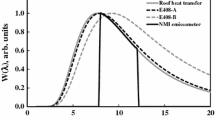Abstract
The energy balance of small temperature sensors was modelled to illustrate the effects of sensor characteristics, particularly size, on the accuracy of readings in the presence of strong shortwave or longwave radiant loads. For all but extremely small sensors, radiant exchange may lead to unacceptable errors. The common practice of using passively ventilated instrument screens was evaluated in a series of comparative measurements. The differences resulting from the use of different models of shields may be an order of magnitude greater than the error resulting from sensor calibration. In the absence of technological innovation capable of reducing the error due to radiant exchange to negligible proportions, it is suggested that a standard methodology for calibrating and labelling the error resulting from the characteristics of the screens be adopted, to allow comparison of new data with long-established records.
Similar content being viewed by others
References
Andersson, T. and Mathisson, I.: 1992, ‘A Field Test of Thermometer Screens’, in Instruments and Observing Methods Reports No. 49 (WMO No. 462), WMO, Geneva, 436 pp.
ASHRAE: 1989, ASHRAE Handbook – Fundamentals, American Society of Heating, Refrigerating and Air Conditioning Engineers, Inc., Atlanta, GA.
E. Erell Y. Etzion Carlstrom M. Sandberg J. Molina I. Maestre E. Maldonado V. Leal O. Gutschker (2004) ArticleTitle‘SOLVENT: Development of a Reversible Solar-Screen Glazing System’ Energ. Build 36 468–480
C. S. B. Grimmond T. R. Oke (1995) ArticleTitle‘Comparison of Heat Fluxes from Summertime Observations in the Suburbs of Four North American Cities’ J. Appl. Meteorol 34 873–889
J. P. Holman (1997) Heat Transfer EditionNumber8 McGraw-Hill New York 688
F. Incropera D. De Witt (1990) Fundamentals of Heat and Mass Transfer EditionNumber3 John Wiley Sons New York 919
I. Livada M. Santamouris K. Niachou N. Papanikolaou G. Mihalakakou (2002) ArticleTitle‘Determination of Places in the Great Athens Area Where the Heat Island Effect is Observed’ Theor. Appl. Climatol 71 219–230
I. Longley M. Gallagher J. Dorsey M. Flynn J. Barlow (2004) ArticleTitle‘Short-Term Measurements of Airflow and Turbulence in Two Street Canyons in Manchester’ Atmos. Environ 38 69–79
G. W. Lowery R. I. Vachon (1975) ArticleTitle‘The Effect of Turbulence on the Heat Transfer from Heated Cylinders’ Int. J. Heat Mass Trans 18 1229–1242
N. Magee J. Curtis G. Wendler (1999) ArticleTitle‘The Urban Heat Island Effect at Fairbanks, Alaska’ Theor. Appl. Climatol 64 39–47
M. Martin (1989) ‘Radiative Cooling’ J. Cook (Eds) Passive Cooling The MIT Press Cambridge, MA 138–196
C. J. G. Morris I. Simmonds (2001) ArticleTitle‘Quantification of the Influences of Wind and Cloud on the Nocturnal Urban Heat Island of a Large City’ J. Appl. Meteorol 40 169–182
L. B. Newman E. M. Sparrow E. R. Eckert (1972) ArticleTitle‘Free-Stream Turbulence Effects on Local Heat Transfer from a Sphere’ Heat Transfer Trans. ASME 94 7–16
T. R. Oke (1973) ArticleTitle‘City Size and the Urban Heat Island’ Atmos. Environ 7 769–779
T. Peterson D. Easterling T. Karl P. Groisman N. Nicholls N. Plummer S. Torok I. Auer R. Boehm D.,. Guillet et al. (1998) ArticleTitle‘Homogeneity Adjustments on In Situ Atmospheric Climate Data: A Review’ Int. J. Climatol 18 1493–1517
H. Schlichting (1979) Boundary-Layer Theory EditionNumber7 McGraw-Hill New York 817
B. Shiau Y. Chen (2002) ArticleTitle‘Observation on Wind Turbulence Characteristics and Velocity Spectra near the Ground at the Coastal Region’ J. Wind Eng. Ind. Aerodyn 90 1771–1681
W. Sparks (1972) The Effect of Thermometer Screen Design on the Observed Temperature WMO No. 315, Geneva 106
R. Stull (1988) An Introduction to Boundary-Layer Meteorology Kluwer Academic Publishers Dordrecht 666
van der Meulen, J.: 1998, ‘A Thermometer Screen Intercomparison’, in Instruments and Observing Methods Reports No. 70 (WMO/TD – No. 877), World Meteorological Organisation, Geneva, 319 pp.
H. A. L. van Dijk (1997) ‘The PASSYS Test Method to Obtain Thermal and Solar Characteristics of Building Components’ N. Foster H. Scheer (Eds) Solar Energy in Architecture and Urban Planning: Proceedings of the Third European Conference on Architecture, Florence, Italy, May 17–21, 1993 James and James Science Publishers London 84–87
C. Willmott (1981) ArticleTitle‘On the Validation of Models’ Phys. Geog 2 184–194
Author information
Authors and Affiliations
Corresponding author
Rights and permissions
About this article
Cite this article
Erell, E., Leal, V. & Maldonado, E. Measurement of air temperature in the presence of a large radiant flux: an assessment of passively ventilated thermometer screens. Boundary-Layer Meteorol 114, 205–231 (2005). https://doi.org/10.1007/s10546-004-8946-8
Received:
Issue Date:
DOI: https://doi.org/10.1007/s10546-004-8946-8




